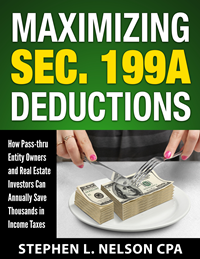 Ready to help your small business clients save thousands in taxes using the Section 199A loophole?
Ready to help your small business clients save thousands in taxes using the Section 199A loophole?
Click the button below to download and purchase the “Maximizing Section 199A Deductions” e-book (price $50, roughly 140 pages) :
Tip: If you want a paper copy instead, no problem! Just order the printed book from Amazon (price $40, roughly 170 pages).
The Bestselling Book on Section 199A Deduction
Section 199A provides owners of pass-through entities with a deduction equal, potentially, to 20% of their business income.
The law, however, presents small businesses and individual investors with some tricky-to-manage rules and, for high income taxpayers, with more complicated accounting.
Hence, this book for tax accountants, financial advisers and business attorneys… It covers in detail how the new deduction works–including updates for the official IRS guidance provided through the fall of 2019. And it discusses what taxpayers and their accountants, advisers and attorneys need to do—in some cases immediately—to maximize the tax savings available.
Already, thousands of CPA firms have used this resource to learn the law and begin helping their business clients.
Money Back Guarantee for Downloadable Edition
We’re of course providing a money-back guarantee for the downloadable edition… If you don’t find our e-book saves you several hours of time and lets you more quickly start helping clients with this wonderful new tax shelter, just email us and ask for a refund.
Table of Contents
“Maximizing Section 199A Deductions” provides tax accountants, advisers, attorneys and sophisticated taxpayers with all the information they need (dozens of simple examples) to start work on maximizing this tax planning opportunity, including:
- Chapter 1 – The Section 199A Deduction in a Nutshell: A practitioner’s overview of the deduction to understand the big picture and begin thinking in broad brush strokes about how the deduction works for small businesses, real estate investors, and investors in REITs and qualified publicly traded partnerships.
- Chapter 2 – What Counts as Qualified Business Income: Detailed discussions of exactly what types of business income taxpayers can shelter with the Section 199A deduction, with specific discussions of the rules that apply to different types of business owners and investors: sole proprietorships, partnerships, S corporations, trusts and estates, and then investors in REITs and qualified publicly traded partnership. Also, coverage of how qualified business income accounting works for Section 1031 exchanges, Section 1031 involuntary transfers and for Section 351 incorporations and Section 721 partnership formations.
- Chapter 3 – Specified Service Trade or Business Disqualification: In-depth coverage of which types of businesses lose some or all of the Section 199A deduction as a result of falling into a specified service trade or business like health services, law, consulting, accounting, actuarial science, performing arts, athletics, investment services, brokerage and trading services, and situations where the business relies on the skill or reputation of a single celebrity.
- Chapter 4 – Accounting for W-2 Wages and Depreciable Property: Every pass-through entity (so every partnership and S corporation) needs to provide detailed accounting for a business’s wages and depreciable property because some taxpayers need this information in order to calculate their Section 199A deduction. Chapter 4 walks the reader through this burdensome area of the new law.
- Chapter 5 – Multiple Trades or Businesses: Chapter 5 describes the additional accounting and reporting required for situations where an individual owns interests in multiple trades or businesses. Chapter 5 also describes the rules for making an aggregation election–and when the aggregation election makes sense.
- Chapter 6 – Fourteen Section 199A Deduction Tax Planning Tips: More than a dozen practical, common-sensed tactics tax accountants and advisers can discuss with their clients to start saving thousands in taxes.
- Chapter 7 – Un-incorporation and S Status Revocation: Detailed analysis of when an S corporation should liquidate or revoke its S corporation status in order to maximize tax savings.
- Chapter 8 – Section 199A Tax Return Preparation Checklist: Just what it says: A checklist of steps taxpayers will want to take in order to maximize the deduction for their 2019 tax return (filed in 2020).
- Chapter 9 – Specified Agricultural and Horticultural Cooperatives and their Patrons: Overview discussion and examples of the rather complicated rules (including the “grain glitch” fix) for specified agricultural and horticultural cooperatives and their members
The book also includes two appendices… the first provides FAQs tax professionals can share with their clients (via email or traditional letters) to help clients understand the Section 199A opportunity… the second provides the text of the Section 199A law including the technical corrections.